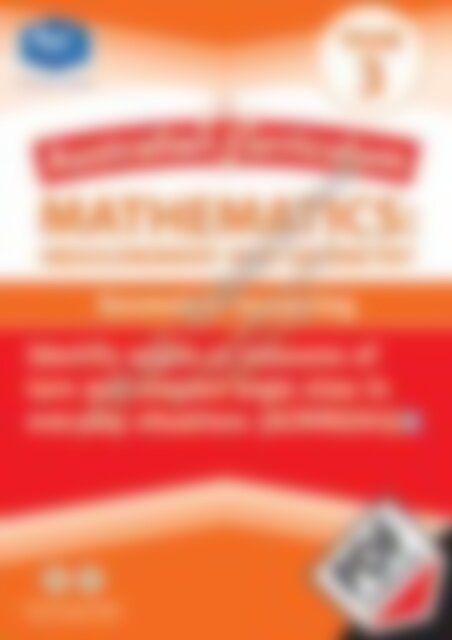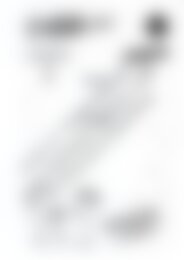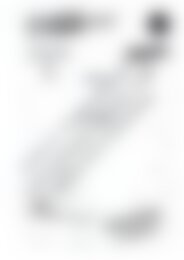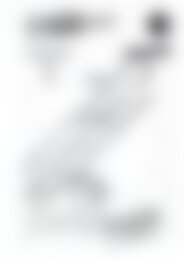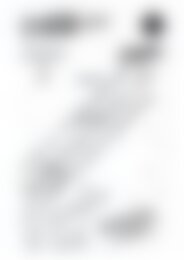RIC-20153 ACM Measurement and Geometry (Yr 3) Geometric reasoning
You also want an ePaper? Increase the reach of your titles
YUMPU automatically turns print PDFs into web optimized ePapers that Google loves.
©R.I.C. Publications<br />
Low Resolution Images<br />
Display Copy
Australian Curriculum Mathematics<br />
resource book: <strong>Measurement</strong> <strong>and</strong> <strong>Geometry</strong><br />
(Year 3)<br />
Published by R.I.C. Publications ® 2013<br />
Copyright © Linda Marshall 2013<br />
<strong>RIC</strong>– <strong>20153</strong><br />
Titles in this series:<br />
Australian Curriculum Mathematics resource book:<br />
<strong>Measurement</strong> <strong>and</strong> <strong>Geometry</strong> (Foundation)<br />
Australian Curriculum Mathematics resource book:<br />
<strong>Measurement</strong> <strong>and</strong> <strong>Geometry</strong> (Year 1)<br />
Australian Curriculum Mathematics resource book:<br />
<strong>Measurement</strong> <strong>and</strong> <strong>Geometry</strong> (Year 2)<br />
Australian Curriculum Mathematics resource book:<br />
<strong>Measurement</strong> <strong>and</strong> <strong>Geometry</strong> (Year 3)<br />
Australian Curriculum Mathematics resource book:<br />
<strong>Measurement</strong> <strong>and</strong> <strong>Geometry</strong> (Year 4)<br />
Australian Curriculum Mathematics resource book:<br />
<strong>Measurement</strong> <strong>and</strong> <strong>Geometry</strong> (Year 5)<br />
Australian Curriculum Mathematics resource book:<br />
<strong>Measurement</strong> <strong>and</strong> <strong>Geometry</strong> (Year 6)<br />
All material identified by is material subject to<br />
copyright under the Copyright Act 1968 (Cth) <strong>and</strong> is owned<br />
by the Australian Curriculum, Assessment <strong>and</strong> Reporting<br />
Authority 2013.<br />
For all Australian Curriculum material except<br />
elaborations: This is an extract from the Australian<br />
Curriculum.<br />
Elaborations: This may be a modified extract from the<br />
Australian Curriculum <strong>and</strong> may include the work of other<br />
authors.<br />
Disclaimer: ACARA neither endorses nor verifies the<br />
accuracy of the information provided <strong>and</strong> accepts no<br />
responsibility for incomplete or inaccurate information. In<br />
particular, ACARA does not endorse or verify that:<br />
• The content descriptions are solely for a particular year<br />
<strong>and</strong> subject;<br />
• All the content descriptions for that year <strong>and</strong> subject<br />
have been used; <strong>and</strong><br />
• The author’s material aligns with the Australian<br />
Curriculum content descriptions for the relevant year<br />
<strong>and</strong> subject.<br />
You can find the unaltered <strong>and</strong> most up to date version of<br />
this material at<br />
http://www.australiancurriculum.edu.au/<br />
This material is reproduced with the permission of ACARA.<br />
Copyright Notice<br />
A number of pages in this book are worksheets.<br />
The publisher licenses the individual teacher who<br />
purchased this book to photocopy these pages to h<strong>and</strong><br />
out to students in their own classes.<br />
Except as allowed under the Copyright Act 1968, any<br />
other use (including digital <strong>and</strong> online uses <strong>and</strong> the<br />
creation of overhead transparencies or posters) or any<br />
use by or for other people (including by or for other<br />
teachers, students or institutions) is prohibited. If you<br />
want a licence to do anything outside the scope of the<br />
BLM licence above, please contact the Publisher.<br />
This information is provided to clarify the limits of this<br />
licence <strong>and</strong> its interaction with the Copyright Act.<br />
For your added protection in the case of copyright<br />
inspection, please complete the form below. Retain this<br />
form, the complete original document <strong>and</strong> the invoice<br />
or receipt as proof of purchase.<br />
Name of Purchaser:<br />
Date of Purchase:<br />
Supplier:<br />
School Order# (if applicable):<br />
Signature of Purchaser:<br />
©R.I.C. Publications<br />
Low Resolution Images<br />
Display Copy<br />
Internet websites<br />
In some cases, websites or specific URLs may be recommended. While these are checked <strong>and</strong> rechecked at the time of publication,<br />
the publisher has no control over any subsequent changes which may be made to webpages. It is strongly recommended that the class<br />
teacher checks all URLs before allowing students to access them.<br />
View all pages online<br />
PO Box 332 Greenwood Western Australia 6924<br />
Website: www.ricpublications.com.au<br />
Email: mail@ricgroup.com.au
AUSTRALIAN CUR<strong>RIC</strong>ULUM MATHEMATICS<br />
RESOURCE BOOK:<br />
MEASUREMENT AND GEOMETRY<br />
(YEAR 3)<br />
Foreword<br />
Australian Curriculum Mathematics resource book: <strong>Measurement</strong> <strong>and</strong> <strong>Geometry</strong> (Year 3) is one in a series of seven teacher resource books that support<br />
teaching <strong>and</strong> learning activities in Australian Curriculum Mathematics. The books focus on the measurement <strong>and</strong> geometry content str<strong>and</strong>s of the<br />
national maths curriculum. The resource books include theoretical background information, resource sheets, h<strong>and</strong>s-on activities <strong>and</strong> assessment<br />
activities, along with links to other curriculum areas.<br />
Format of this book ................................................. iv – v<br />
Using units of measurement .................................... 2–29<br />
• UUM – 1<br />
Measure, order <strong>and</strong> compare objects using familiar metric units of<br />
length, mass <strong>and</strong> capacity (<strong>ACM</strong>MG061)<br />
– Teacher information ............................................................................... 2–4<br />
– H<strong>and</strong>s-on activities ................................................................................. 5–7<br />
– Links to other curriculum areas ................................................................... 8<br />
– Resource sheets .................................................................................... 9–12<br />
– Assessment ........................................................................................ 13–14<br />
– Checklist ................................................................................................... 15<br />
• UUM – 2<br />
Tell time to the minute <strong>and</strong> investigate the relationship between units<br />
of time (<strong>ACM</strong>MG062)<br />
– Teacher information ........................................................................... 16–17<br />
– H<strong>and</strong>s-on activities ................................................................................... 18<br />
– Links to other curriculum areas ................................................................. 19<br />
– Resource sheets .................................................................................. 20–25<br />
– Assessment ........................................................................................ 26–27<br />
– Checklist ................................................................................................... 28<br />
Answers .................................................................................. 29<br />
Shape .................................................................... 30–45<br />
• Shape – 1<br />
Make models of three-dimensional objects <strong>and</strong> describe key<br />
features (<strong>ACM</strong>MG063)<br />
– Teacher information ........................................................................... 30–31<br />
– H<strong>and</strong>s-on activities ................................................................................... 32<br />
– Links to other curriculum areas ................................................................. 33<br />
– Resource sheets .................................................................................. 34–39<br />
– Assessment ........................................................................................ 40–43<br />
– Checklist ................................................................................................... 44<br />
Answers .................................................................................. 45<br />
Contents<br />
Location <strong>and</strong> transformation .................................. 46–71<br />
• L&T – 1<br />
Create <strong>and</strong> interpret simple grid maps to show position <strong>and</strong><br />
pathways (<strong>ACM</strong>MG065)<br />
– Teacher information .................................................................................. 46<br />
– H<strong>and</strong>s-on activities ............................................................................. 47–48<br />
– Links to other curriculum areas .................................................................. 49<br />
– Resource sheets .................................................................................. 50–56<br />
– Assessment ........................................................................................ 57–58<br />
– Checklist .................................................................................................... 59<br />
• L&T – 2<br />
Identify symmetry in the environment (<strong>ACM</strong>MG066)<br />
– Teacher information .................................................................................. 60<br />
– H<strong>and</strong>s-on activities .................................................................................... 61<br />
– Links to other curriculum areas .................................................................. 62<br />
– Resource sheets .................................................................................. 53–67<br />
– Assessment ........................................................................................ 68–69<br />
– Checklist .................................................................................................... 70<br />
©R.I.C. Publications<br />
Low Resolution Images<br />
Display Copy<br />
Answers .................................................................................. 71<br />
<strong>Geometric</strong> <strong>reasoning</strong> .............................................. 72–82<br />
• GR – 1<br />
Identify angles as measures of turn <strong>and</strong> compare angle sizes in<br />
everyday situations (<strong>ACM</strong>MG064)<br />
– Teacher information ........................................................................... 72–73<br />
– H<strong>and</strong>s-on activities ............................................................................. 74–75<br />
– Links to other curriculum areas .................................................................. 76<br />
– Resource sheets .................................................................................. 77–78<br />
– Assessment ........................................................................................ 79–80<br />
– Checklist .................................................................................................... 81<br />
Answers .................................................................................. 82<br />
Australian Curriculum Mathematics resource book: <strong>Measurement</strong> <strong>and</strong> <strong>Geometry</strong> (Year 3) R.I.C. Publications ® www.ricpublications.com.au iii
FORMAT OF THIS BOOK<br />
This teacher resource book includes supporting materials for teaching <strong>and</strong> learning in all sections of the <strong>Measurement</strong> <strong>and</strong> <strong>Geometry</strong> content str<strong>and</strong> of<br />
Australian Curriculum Mathematics. It includes activities relating to all sub-str<strong>and</strong>s: Using units of measurement, Shape, Location <strong>and</strong> transformation,<br />
<strong>and</strong> <strong>Geometric</strong> <strong>reasoning</strong>. All content descriptions have been included, as well as teaching points based on the Curriculum’s elaborations. Links to the<br />
proficiency str<strong>and</strong>s have also been included.<br />
Each section supports a specific content description <strong>and</strong> follows a consistent format, containing the following information over several pages:<br />
• teacher information with related terms, student vocabulary, what the content description means, teaching points <strong>and</strong> problems to watch for<br />
• h<strong>and</strong>s-on activities<br />
• resource sheets<br />
• a checklist<br />
• links to other curriculum areas<br />
• assessment sheets.<br />
Answers relating to the resource <strong>and</strong> assessment pages are included on the final page of the section for each sub-str<strong>and</strong> (Using units of measurement,<br />
Shape, Location <strong>and</strong> transformation, <strong>and</strong> <strong>Geometric</strong> <strong>reasoning</strong>).<br />
The length of each content description section varies.<br />
Related terms includes vocabulary associated<br />
with the content description. Many of these<br />
relate to the glossary in the back of the official<br />
Australian Curriculum Mathematics document;<br />
additional related terms may also have been<br />
added.<br />
Student vocabulary includes words which<br />
the teacher would use—<strong>and</strong> expect the<br />
students to learn, underst<strong>and</strong> <strong>and</strong> use—during<br />
mathematics lessons.<br />
The proficiency str<strong>and</strong>(s) (Underst<strong>and</strong>ing,<br />
Fluency, Problem Solving solving or Reasoning) relevant<br />
to each content description are listed. shown in bold.<br />
Teacher information includes background information relating to the content description, as well as<br />
related terms, desirable student vocabulary <strong>and</strong> other useful details which may assist the teacher.<br />
Sub-str<strong>and</strong>: Location <strong>and</strong> transformation— L&T – 1<br />
Create <strong>and</strong> interpret simple grid maps to show position <strong>and</strong> pathways (<strong>ACM</strong>MG065)<br />
RELATED TERMS<br />
Grid maps<br />
vever<br />
<br />
s.<br />
w<br />
(x<br />
ver(y<br />
Position<br />
T<br />
<br />
r<br />
s.<br />
Pathway<br />
T<br />
.<br />
Coordinates (Cartesian<br />
coordinates)<br />
<br />
repr<br />
<br />
<br />
<br />
<br />
<br />
<br />
r<br />
s.<br />
Student vocabulary<br />
coordinates<br />
north<br />
south<br />
east<br />
west<br />
clockwise<br />
anticlockwise<br />
right<br />
left<br />
forward<br />
backwards<br />
over<br />
under<br />
turn<br />
paces<br />
steps<br />
Notewe<br />
‘a<br />
<br />
’.<br />
TEACHER INFORMATION<br />
What this means<br />
<br />
<br />
<br />
’<br />
<br />
’<br />
’<br />
<br />
.<br />
<br />
<br />
<br />
Teaching points<br />
T<br />
e.<br />
<br />
<br />
.<br />
5<br />
<br />
4<br />
x<br />
y 3<br />
<br />
2<br />
<br />
1<br />
s.<br />
A B C D E<br />
What to look for<br />
<br />
.<br />
Students’<br />
<br />
<br />
.<br />
<br />
e.<br />
.<br />
<br />
yx<br />
.<br />
e.<br />
Proficiency str<strong>and</strong>(s):<br />
Underst<strong>and</strong>ing Problem solving<br />
F<br />
<br />
46 Australian Curriculum Mathematics resource book: <strong>Measurement</strong> <strong>and</strong> <strong>Geometry</strong> (Year 3) R.I.C. Publications ® www.ricpublications.com.au<br />
What this means provides<br />
a general explanation of the<br />
content description.<br />
Teaching points provides<br />
a list of the main teaching<br />
points relating to the content<br />
description.<br />
What to watch look for for suggests any any<br />
difficulties <strong>and</strong> misconceptions<br />
the students might encounter or<br />
develop.<br />
©R.I.C. Publications<br />
Low Resolution Images<br />
Display Copy<br />
Sub-str<strong>and</strong>: Location <strong>and</strong> transformation— L&T– 1<br />
HANDS–ON ACTIVITIES<br />
Grid moves game<br />
<br />
<br />
‘’.<br />
‘Move 2 squares to the left <strong>and</strong> up 3 squares’<br />
all<br />
students<br />
H<strong>and</strong>s-on activities includes descriptions or<br />
instructions for games or activities relating to the<br />
content descriptions or elaborations. Some of the<br />
h<strong>and</strong>s-on activities are supported by resource<br />
sheets. Where applicable, these will be stated for<br />
easy reference.<br />
1<br />
4<br />
2<br />
3<br />
<br />
<br />
<br />
Is the bookcase bigger or smaller<br />
than the easel? How much bigger is the teacher’s desk than any of the other desks?<br />
<br />
<br />
<br />
<br />
.<br />
<br />
<br />
<br />
yxy<br />
Where is the library? How would you get<br />
from the office to the car park? What are the coordinates of the art room? What is the shortest way to get from the canteen to<br />
the oval? What other ways could you get there?<br />
<br />
<br />
First to ten game: <br />
<br />
<br />
Australian Curriculum Mathematics resource book: <strong>Measurement</strong> <strong>and</strong> <strong>Geometry</strong> (Year 3) R.I.C. Publications ® www.ricpublications.com.au 47<br />
iv Australian Curriculum Mathematics resource book: <strong>Measurement</strong> <strong>and</strong> <strong>Geometry</strong> (Year 3) R.I.C. Publications ® www.ricpublications.com.au
(c)<br />
(e)<br />
(a)<br />
(d)<br />
(f)<br />
(b)<br />
No lines of symmetry<br />
There are<br />
an infinite<br />
number<br />
of lines of<br />
symmetry in<br />
a circle.<br />
No lines of symmetry<br />
(d)<br />
(a) (b) (c)<br />
(f)<br />
(h)<br />
(g)<br />
(e)<br />
(i)<br />
FORMAT OF THIS BOOK<br />
Links to other curriculum areas includes activities in other curriculum areas which support<br />
the content description. These are English, Information <strong>and</strong> Communication Technology, Health<br />
<strong>and</strong> Physical Education, History, Geography, the Arts <strong>and</strong> Languages). This section may list many<br />
links or only a few. It may also provide links to relevant interactive websites appropriate for the<br />
age group.<br />
Cross-curricular links reinforce the knowledge that mathematics can be found within, <strong>and</strong> relate<br />
to, many other aspects of student learning <strong>and</strong> everyday life.<br />
CONTENT DESCRIPTION: Create <strong>and</strong> interpret simple grid maps to show position <strong>and</strong> pathways<br />
Sub-str<strong>and</strong>: Location <strong>and</strong> transformation— L&T – 1<br />
Australian Curriculum Mathematics resource book: <strong>Measurement</strong> <strong>and</strong> <strong>Geometry</strong> (Year 3) R.I.C. Publications ® www.ricpublications.com.au 55<br />
Sub-str<strong>and</strong>: Location <strong>and</strong> transformation— L&T – 1<br />
Create <strong>and</strong> interpret simple grid maps to show position <strong>and</strong> pathways (<strong>ACM</strong>MG065)<br />
STUDENT NAME<br />
RESOURCE SHEET<br />
The new suburb<br />
Below is part of a map of a new suburb.<br />
The map is missing some details. Show:<br />
1. Traffic lights at the corner of White <strong>and</strong> Green Streets<br />
2. A shop at G4<br />
3. A car park east of Black Lane <strong>and</strong> south of Yellow Rd<br />
4. A park between Green <strong>and</strong> Yellow Roads, with a slide at B5 <strong>and</strong> swings<br />
at C6<br />
5. Orange Ave one-way heading west<br />
6. A mail box at K8 <strong>and</strong> a café at A3<br />
7. A building of your choice at F2 <strong>and</strong> F3.<br />
8. Describe how to get from the mail box to the café.<br />
Uses simple<br />
coordinates<br />
Creates simple grid<br />
maps<br />
Interprets simple<br />
grid maps<br />
North<br />
Checklist<br />
Identifies relative<br />
positions on a map<br />
Resource sheets are provided to support<br />
teaching <strong>and</strong> learning activities for each<br />
content description. The resource sheets<br />
could be cards for games, charts, additional<br />
worksheets for class use or other materials<br />
which the teacher might find useful to use or<br />
display in the classroom. For each resource<br />
sheet, the content description to which it<br />
relates is given.<br />
Assessment pages are included. These<br />
support activities included in the H<strong>and</strong>s-on<br />
activities or resource sheets.<br />
Each section has a checklist which teachers<br />
may find useful as a place to keep a record of<br />
the results of assessment activities, or their<br />
observations of h<strong>and</strong>s-on activities.<br />
Sub-str<strong>and</strong>: Location <strong>and</strong> transformation— L&T – 1<br />
English<br />
Australian Curriculum Mathematics resource book: <strong>Measurement</strong> <strong>and</strong> <strong>Geometry</strong> (Year 3) R.I.C. Publications ® www.ricpublications.com.au 49<br />
Assessment 2 Sub-str<strong>and</strong>: Location Sub-str<strong>and</strong>: transformation— Shape—Shape L&T – 1<br />
NAME:<br />
58 Australian Curriculum Mathematics resource book: <strong>Measurement</strong> <strong>and</strong> <strong>Geometry</strong> (Year 3) R.I.C. Publications ® www.ricpublications.com.au<br />
Sub-str<strong>and</strong>: Location <strong>and</strong> transformation<br />
L&T – 1<br />
Page 55 Resource sheet – The new suburb<br />
1.–8. Teacher check<br />
Page 56 Assessment 1 – The clothes line<br />
1. jeans<br />
2. second from the left on the top line<br />
3. skirt<br />
4. 3<br />
5. 4<br />
6. Teacher check<br />
7. Teacher check<br />
Ring a Toy<br />
Page 65<br />
DATE:<br />
Below is a game used at a school fete. The aim is to throw hoops over the<br />
squares <strong>and</strong> if you l<strong>and</strong> on a toy, you win it.<br />
5<br />
4<br />
3<br />
2<br />
1<br />
1. What is the toy in D3?<br />
2. In what square is the fairy doll?<br />
3. The toy in C4 is a .<br />
4. In what square is the toy train?<br />
5. What is the toy in A5?<br />
LINKS TO OTHER CUR<strong>RIC</strong>ULUM AREAS<br />
Once upon a time map booke.<br />
.<br />
Information <strong>and</strong> Communication Technology<br />
<br />
<br />
<br />
Z<br />
<br />
<br />
<br />
<br />
<br />
<br />
Health <strong>and</strong> Physical Education<br />
Indians <strong>and</strong> tepees <br />
<br />
<br />
’e.<br />
’’<br />
clockwise<br />
’anticlockwise<br />
’<br />
<br />
’’<br />
<br />
.<br />
History <strong>and</strong> Geography<br />
.<br />
A B C D E<br />
6. Draw a toy frog in E2 <strong>and</strong> a toy of your choice in B1.<br />
©R.I.C. Publications<br />
Low Resolution Images<br />
Display Copy<br />
Answers<br />
Resource sheet – Transparent mirror<br />
activity page<br />
CONTENT DESCRIPTION: Create <strong>and</strong> interpret simple grid maps to show position <strong>and</strong> pathways<br />
Australian Curriculum Mathematics resource book: <strong>Measurement</strong> <strong>and</strong> <strong>Geometry</strong> (Year 3) R.I.C. Publications ® www.ricpublications.com.au 59<br />
Answers for resource pages (where<br />
appropriate) <strong>and</strong> assessment pages are<br />
provided on the final page of each sub-str<strong>and</strong><br />
section.<br />
Page 57 Assessment 1 – Near the school<br />
1. a swing<br />
2. B7<br />
3. oval <strong>and</strong> park (or swing)<br />
4. Arrows showing School Street one-way from west to<br />
east. Teacher check.<br />
5. Go left (or west) along Careful Street; turn right<br />
(north) into Park Road; first right into School Street<br />
<strong>and</strong> the hospital is on the left.<br />
Page 58 Assessment 2 – Ring a toy<br />
1. A toy car<br />
2. A2<br />
3. A (beach) ball<br />
4. C1<br />
5. A dog<br />
6. Teacher check<br />
L&T – 2<br />
Page 63 Resource sheet – Symmetry in shapes<br />
1.<br />
Page 66 Resource sheet – Reflections on symmetry<br />
1.–3. Teacher check<br />
Page 67 Resource sheet – Symmetry in the garden<br />
1.<br />
(a) (b) (c)<br />
(d) (e) (f )<br />
2. Teacher check<br />
Page 68 Assessment 1 – Transparent mirror<br />
symmetry<br />
1.<br />
2. Teacher check<br />
Page 69<br />
1. Teacher check<br />
Assessment 2 – Deb <strong>and</strong> Tim’s toy shop<br />
Australian Curriculum Mathematics resource book: <strong>Measurement</strong> <strong>and</strong> <strong>Geometry</strong> (Year 3) R.I.C. Publications ® www.ricpublications.com.au 71<br />
Australian Curriculum Mathematics resource book: <strong>Measurement</strong> <strong>and</strong> <strong>Geometry</strong> (Year 3) R.I.C. Publications ® www.ricpublications.com.au v
Sub-str<strong>and</strong>: <strong>Geometric</strong> <strong>reasoning</strong>—GR – 1<br />
Identify angles as measures of turn <strong>and</strong> compare angle sizes in everyday situations (<strong>ACM</strong>MG064)<br />
RELATED TERMS<br />
TEACHER INFORMATION<br />
Angle<br />
• Two lines with a common end point<br />
called a vertex, or the extent of<br />
rotation about a point.<br />
Right angle 90°<br />
• Exactly 90°.<br />
Acute angle<br />
• An angle less than 90°.<br />
Obtuse angle<br />
• Greater than 90° but less than 180°.<br />
Straight angle<br />
• Exactly 180°.<br />
One rotation<br />
• A full turn to end up at the start (360°).<br />
Degree<br />
• A unit of measure of an angle, based<br />
on there being 360° in a circle.<br />
• Students need to be aware that<br />
degrees are also used to measure<br />
temperature, but this is not the same<br />
as the measure for angle.<br />
What this means<br />
• Right angles (those of approximately 90°) are ones that students should<br />
recognise.<br />
• Knowledge that an acute angle is less than 90°.<br />
• Knowledge that an obtuse angle is between 90° <strong>and</strong> 180°.<br />
• Knowledge that a full turn is the same as 360° <strong>and</strong> that half a turn is 180°.<br />
• Students are developing an awareness <strong>and</strong> underst<strong>and</strong>ing of<br />
the movement that relates to how angles are formed <strong>and</strong> to the<br />
measurement of angles.<br />
• The use of a protractor is not encouraged at this stage.<br />
Teaching points<br />
• Angles are classified by their size in their relationship to the right angle<br />
(90°). (Refer to related terms.)<br />
• Right angles are used extensively in most buildings. For example, where<br />
walls meet the floor <strong>and</strong> the ceiling, the corners of rooms <strong>and</strong> most of<br />
the angles in the construction of cupboards. Books <strong>and</strong> paper mostly<br />
have 90° angles.<br />
• Many doors open to 180°, though if near a corner, they may only open to<br />
about 90°.<br />
• Make links to the unit on time (UUM – 2) looking at the h<strong>and</strong>s on an<br />
analogue clock as they turn in a clockwise direction.<br />
• Also make links to the unit on location <strong>and</strong> transformation (L&T – 1)<br />
where quarter <strong>and</strong> half turns are used, along with ideas about the four<br />
cardinal compass points (north, south, east <strong>and</strong> west) <strong>and</strong> left/right <strong>and</strong><br />
clockwise/anticlockwise.<br />
• Students can get an intuitive idea of the size of angles when making<br />
comparisons. For example, that the size of the angles on the hexagon<br />
piece of pattern blocks are greater than a right angle (90°) <strong>and</strong> also<br />
much bigger than the size of the angles on the triangular block, which<br />
are less than a right angle. At this stage, they do not need to measure<br />
the angles on the two pieces.<br />
©R.I.C. Publications<br />
Low Resolution Images<br />
Display Copy<br />
• Show right angles in different orientations. This should help avoid a<br />
common misconception that we can have right angles <strong>and</strong> ‘left angles’.<br />
Student vocabulary<br />
right angle<br />
acute angle<br />
obtuse angle<br />
straight angle<br />
degrees<br />
rotation<br />
arms (of an angle)<br />
• It is important to make angles with different arm lengths so students<br />
realise that the length of the arms does not affect the size of an angle.<br />
• National tests often include a question on angles, where students<br />
identify the largest or smallest angles from a set of angles that have<br />
different arm lengths.<br />
72 Australian Curriculum Mathematics resource book: <strong>Measurement</strong> <strong>and</strong> <strong>Geometry</strong> (Year 3) R.I.C. Publications ® www.ricpublications.com.au
Sub-str<strong>and</strong>: <strong>Geometric</strong> <strong>reasoning</strong>—GR – 1<br />
Identify angles as measures of turn <strong>and</strong> compare angle sizes in everyday situations (<strong>ACM</strong>MG064)<br />
TEACHER INFORMATION<br />
What to look for<br />
• Students know the properties of a right angle (90°) <strong>and</strong> can represent<br />
them without the use of a protractor. (Note: Protractors are not<br />
encouraged at this year level).<br />
• Students are aware that a straight angle is 180° (which is two right<br />
angles) <strong>and</strong> a full rotation is 360° (which is four right angles).<br />
• Students confused by the length of the arms of an angle, thinking that<br />
an angle with short arms is less than an angle of lesser degrees but<br />
with longer arms. Students with this misconception would judge that<br />
the first angle below is wider than the second because of the length of<br />
the arms. In fact, the second angle is larger.<br />
©R.I.C. Publications<br />
Low Resolution Images<br />
Display Copy<br />
Proficiency str<strong>and</strong>(s):<br />
Underst<strong>and</strong>ing<br />
Fluency<br />
Problem solving<br />
Reasoning<br />
Australian Curriculum Mathematics resource book: <strong>Measurement</strong> <strong>and</strong> <strong>Geometry</strong> (Year 3) R.I.C. Publications ® www.ricpublications.com.au 73
Sub-str<strong>and</strong>: <strong>Geometric</strong> <strong>reasoning</strong>—GR – 1<br />
HANDS–ON ACTIVITIES<br />
• In this unit, students will mostly compare angles to the right angle (90°). This would involve recognising that a straight<br />
angle is two right angles (180°) <strong>and</strong> a full turn is four right angles (360°). Discuss the idea that right angles occur all<br />
around us, including the corners of pieces of paper, books, corners in rooms etc.<br />
• One method of introducing<br />
students to the idea of angles is<br />
to get them to (very carefully)<br />
trace the cutting edge of an<br />
open pair of scissors.<br />
• Students make an angle demonstrator (see page 77). They use these to show various angles such as 90°, an angle<br />
less than 90°, an angle greater than 90°, a straight angle <strong>and</strong> a full turn. Students find ways to record their results. Play<br />
games where the teacher (or a student) calls out an angle size (from the five mentioned above) <strong>and</strong> the students make<br />
that angle with their angle demonstrator <strong>and</strong> hold it up for the teacher to check.<br />
• Students make an angle unit measure that can be<br />
used as a non-st<strong>and</strong>ard unit. One version of this is to<br />
cut a sharp angle from a piece of cardboard. Allow the<br />
students to decide on how ‘pointy’ the angle is, but<br />
‘quite pointy’ would be the instruction. Students then<br />
use their angle unit measures to measure different<br />
angles. Note that as the students have each decided<br />
on the ‘pointiness’ of their angle unit measure, there<br />
will be a variation of results for the same measuring<br />
activity, as there is when measuring the length of a<br />
table using the non-st<strong>and</strong>ard unit of h<strong>and</strong> spans.<br />
• Another way to compare angles without a<br />
protractor is for students to make a different type<br />
of angle unit measure. This involves using a circle<br />
of light card. Students fold the circle in half, in half<br />
again, a third time, <strong>and</strong> finally a fourth time. When<br />
this is opened out, there are 16 equal (or very nearly<br />
equal) segments that become the units of the<br />
angle unit measure. Students then can use these to<br />
measure the size of angles in terms of the number<br />
of segments needed on their angle unit measure.<br />
Students may make the link to the fact that four of<br />
these angle unit segments make a right angle (90°).<br />
My angle demonstrator is showing a straight line, which is 180°.<br />
My angle unit<br />
measure<br />
©R.I.C. Publications<br />
Low Resolution Images<br />
Display Copy<br />
I needed 4 of my angle unit segments to be<br />
the same as the corner of my book.<br />
74 Australian Curriculum Mathematics resource book: <strong>Measurement</strong> <strong>and</strong> <strong>Geometry</strong> (Year 3) R.I.C. Publications ® www.ricpublications.com.au
Sub-str<strong>and</strong>: <strong>Geometric</strong> <strong>reasoning</strong>—GR – 1<br />
HANDS–ON ACTIVITIES (CONTINUED)<br />
• Students look for objects that can rotate through a full turn, such as a rotary clothesline, helicopter rotors, windmills,<br />
wheels on any vehicles or the h<strong>and</strong>s on a clock. Describe this as a ‘full turn’, which can then be related to 360°.<br />
• Students look for objects that can rotate through part of a full turn, such as doors, the tray on a tip truck, pages in a<br />
book, swings or scissors. Encourage the use of the terms ‘less than a full turn’, ‘half turn’, ‘quarter turn’ <strong>and</strong> ‘three-quarter<br />
turn’. These terms can then be related to 180° for a half turn <strong>and</strong> 90° for a quarter turn. Relating a three-quarter turn to<br />
270° would not be expected at this year level.<br />
• Opening doors partially or fully gives an idea of angles. Many doors open to 180°, though if near a corner, they may only<br />
open to about 90°. Students could draw what the angle looks like at different points of turn.<br />
• The hour <strong>and</strong> minute h<strong>and</strong>s on a clock make angles as they turn. Students could discuss what angle is formed at certain<br />
times; e.g. 3 o’clock, 9:15, 12 o’clock, 9 o’clock or 12:07. This may link with the unit on time (UUM – 2).<br />
• Links could also be made to the unit on location <strong>and</strong> transformation (L&T – 1) where quarter <strong>and</strong> half turns are used,<br />
along with ideas about the four cardinal compass points (north, south, east <strong>and</strong> west) <strong>and</strong> left/right <strong>and</strong> clockwise/<br />
anticlockwise.<br />
• Students use their arms to demonstrate angles. One arm remains out straight from their body (parallel to the ground);<br />
the other arm can be turned slowly to show a right angle, an angle less than a right angle, an angle greater than a right<br />
angle, a straight angle <strong>and</strong> a full turn.<br />
• Play ‘Simon says’, with the teacher calling out various angle sizes <strong>and</strong> the students making the nominated angle with<br />
their arms. Terms such as ‘right angle’, ‘90°’, ‘less than 90°’, ‘more than 90°’, ‘straight angle’, ‘180°’, ‘full turn’ <strong>and</strong> ‘360°’ could<br />
be used. ‘Clockwise’ <strong>and</strong> ‘anticlockwise’ could also be used to indicate the direction of the turn. If students do not show<br />
the correct angle <strong>and</strong>/or direction, they sit down. The last one st<strong>and</strong>ing is the winner.<br />
• Students use two craftsticks, straws or similar to make different types of angles: right angle, an angle less than a right<br />
angle, an angle greater than a right angle, a straight angle <strong>and</strong> a full turn. The sticks do not need to be joined; one may<br />
just overlay the other.<br />
• Students identify different angles in the room <strong>and</strong> in the outside environment. Try to find examples of right angles,<br />
angles less than 90° <strong>and</strong> angles larger than 90°. Students could look for pictures that illustrate the different angles.<br />
©R.I.C. Publications<br />
Low Resolution Images<br />
Display Copy<br />
• Mix <strong>and</strong> match angles game. The cards on page 78 can be used to reinforce students’ recognition of right angles,<br />
straight angles <strong>and</strong> a full turn.<br />
staight<br />
angle<br />
180°<br />
right<br />
angle<br />
360°<br />
Australian Curriculum Mathematics resource book: <strong>Measurement</strong> <strong>and</strong> <strong>Geometry</strong> (Year 3) R.I.C. Publications ® www.ricpublications.com.au 75
Sub-str<strong>and</strong>: <strong>Geometric</strong> <strong>reasoning</strong>—GR – 1<br />
LINKS TO OTHER CUR<strong>RIC</strong>ULUM AREAS<br />
English<br />
• Make vocabulary cards with drawings <strong>and</strong> definitions for new words associated with angles. For example, ‘right angle’,<br />
‘straight angle’ <strong>and</strong> ‘full turn’. Each of the cards could also make mention of degrees of turn; e.g. 90°, 180° <strong>and</strong> 360°.<br />
Information <strong>and</strong> Communication Technology<br />
• A website that asks students to decide whether the angles shown are greater than a right angle, exactly a right angle<br />
or less than a right angle can be found at .<br />
The explanation when an incorrect answer is entered is very good.<br />
Health <strong>and</strong> Physical Education<br />
• Students make angles using their arms, as described earlier. The teacher, or a student, could make an angle with his or<br />
her arms that the other students copy <strong>and</strong> describe. The person out the front could call out a type of angle for the other<br />
students to make with their arms.<br />
©R.I.C. Publications<br />
Low Resolution Images<br />
Display Copy<br />
76 Australian Curriculum Mathematics resource book: <strong>Measurement</strong> <strong>and</strong> <strong>Geometry</strong> (Year 3) R.I.C. Publications ® www.ricpublications.com.au
Sub-str<strong>and</strong>: <strong>Geometric</strong> <strong>reasoning</strong>—GR – 1<br />
RESOURCE SHEET<br />
Make <strong>and</strong> use an angle demonstrator<br />
• Make two (2) circles about the same size as the one below; one in a light<br />
colour, the other in a darker colour. Carefully cut a line to the centre as<br />
shown below.<br />
CONTENT DESCRIPTION: Identify angles as measures of turn <strong>and</strong> compare angles in everyday turns<br />
©R.I.C. Publications<br />
Low Resolution Images<br />
Display Copy<br />
• Place one circle inside the other as shown. You can now turn one circle of<br />
your angle demonstrator within the other to show different angles.<br />
• Use your angle demonstrator to show a right angle (90°), an angle less than<br />
90° <strong>and</strong> a straight angle (180°). Draw these onto a sheet of paper. How can<br />
you show a full turn?<br />
Australian Curriculum Mathematics resource book: <strong>Measurement</strong> <strong>and</strong> <strong>Geometry</strong> (Year 3) R.I.C. Publications ® www.ricpublications.com.au 77
Sub-str<strong>and</strong>: <strong>Geometric</strong> <strong>reasoning</strong>—GR – 1<br />
RESOURCE SHEET<br />
Mix <strong>and</strong> match angles<br />
Cut out the 12 cards below. Mix them up <strong>and</strong> try to put them back in the<br />
correct groups.<br />
right<br />
angle<br />
straight<br />
angle<br />
90°<br />
180°<br />
full turn 360°<br />
©R.I.C. Publications<br />
Low Resolution Images<br />
Display Copy<br />
CONTENT DESCRIPTION: Identify angles as measures of turn <strong>and</strong> compare angles in everyday turns<br />
78 Australian Curriculum Mathematics resource book: <strong>Measurement</strong> <strong>and</strong> <strong>Geometry</strong> (Year 3) R.I.C. Publications ® www.ricpublications.com.au
Sub-str<strong>and</strong>: <strong>Geometric</strong> <strong>reasoning</strong>—GR – 1 Assessment 1<br />
NAME:<br />
DATE:<br />
What’s my angle?<br />
You will need a wire, bread tie or a pipe cleaner.<br />
Bend your object to make the angle below.<br />
Call this the ‘angle unit’.<br />
CONTENT DESCRIPTION: Identify angles as measures of turn <strong>and</strong> compare angles in everyday turns<br />
1. Now use this to find out if the angles below are bigger, smaller or the same<br />
as your angle unit. Write it under each of the angles.<br />
(a)<br />
(c)<br />
2. How many of your angle units will fit in each of the angles below?<br />
Describe what type of angle each one is.<br />
(a)<br />
(b)<br />
©R.I.C. Publications<br />
Low Resolution Images<br />
Display Copy<br />
Number = Number =<br />
(d)<br />
(b)<br />
Australian Curriculum Mathematics resource book: <strong>Measurement</strong> <strong>and</strong> <strong>Geometry</strong> (Year 3) R.I.C. Publications ® www.ricpublications.com.au 79
Assessment 2 Sub-str<strong>and</strong>: <strong>Geometric</strong> <strong>reasoning</strong>—GR – 1<br />
NAME:<br />
DATE:<br />
What do you know about angles?<br />
Write what you know about each of the types of angles below. Draw an<br />
example of each one.<br />
(a) Draw any angle (what does an<br />
angle measure?)<br />
(b) A right angle<br />
(c) A straight angle (d) A full turn<br />
©R.I.C. Publications<br />
Low Resolution Images<br />
Display Copy<br />
CONTENT DESCRIPTION: Identify angles as measures of turn <strong>and</strong> compare angles in everyday turns<br />
80 Australian Curriculum Mathematics resource book: <strong>Measurement</strong> <strong>and</strong> <strong>Geometry</strong> (Year 3) R.I.C. Publications ® www.ricpublications.com.au
Sub-str<strong>and</strong>: <strong>Geometric</strong> <strong>reasoning</strong>—GR – 1<br />
Identify angles as measures of turn <strong>and</strong> compare angle sizes in everyday situations (<strong>ACM</strong>MG064)<br />
STUDENT NAME<br />
Recognises right angles<br />
Recognises angles greater<br />
than <strong>and</strong> less than 90°<br />
Recognises a straight<br />
angle<br />
Recognises a full turn<br />
©R.I.C. Publications<br />
Low Resolution Images<br />
Display Copy<br />
Australian Curriculum Mathematics resource book: <strong>Measurement</strong> <strong>and</strong> <strong>Geometry</strong> (Year 3) R.I.C. Publications ® www.ricpublications.com.au 81
Sub-str<strong>and</strong>: <strong>Geometric</strong> <strong>reasoning</strong><br />
GR – 1<br />
Answers<br />
Page 79<br />
1.<br />
Assessment 1 – What’s my angle?<br />
(a)<br />
smaller<br />
(c)<br />
bigger<br />
(b)<br />
bigger<br />
(d)<br />
the same size<br />
2.<br />
(a)<br />
Page 80<br />
3 angle units. The angle is<br />
greater than a right angle (90°)<br />
It is an obtuse angle.<br />
Assessment 2 – What do you know<br />
about angles?<br />
Teacher check<br />
(b)<br />
2 angle units. The angle is<br />
less than a right angle (90°).<br />
It is an acute angle.<br />
©R.I.C. Publications<br />
Low Resolution Images<br />
Display Copy<br />
82 Australian Curriculum Mathematics resource book: <strong>Measurement</strong> <strong>and</strong> <strong>Geometry</strong> (Year 3) R.I.C. Publications ® www.ricpublications.com.au


